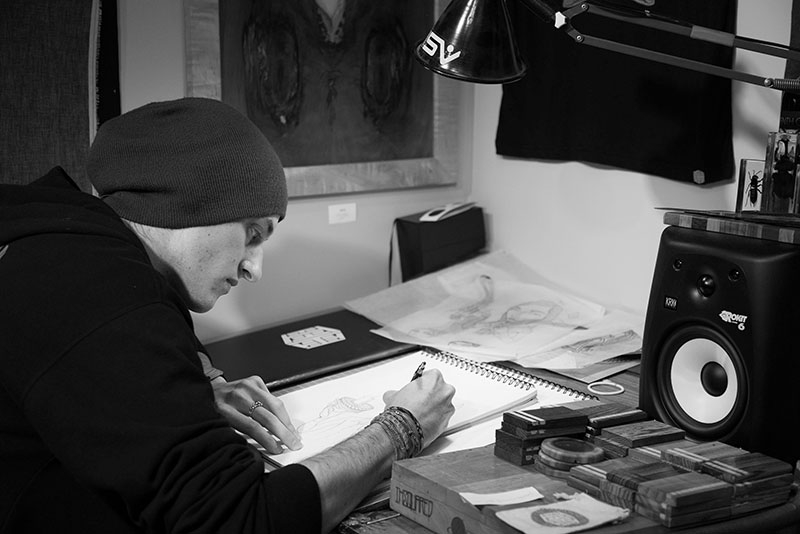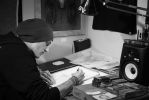
The Mysterious Design of Life and Death: A Profile of Isaac Hastings
Interviews & Features
Isaac Hastings creates cryptic, carefully designed, line-dominant artwork that conveys both spiritually infused and dream-inspired symbols. His meticulous design is featured on the cover of SLUG this month to honor the magazine’s 300th issue.
A self-described “jack of all trades, master of none,” Hastings is humble—he sports a black hoodie, jeans and a beanie during our interview and speaks frankly about his evolution as an artist. Born in Salt Lake and raised in Sugar House, Hastings is based in this mountain-framed city and uses its unique geography, proximity to wilderness and local artistic talent as inspiration.
Hastings labels himself as an illustrator for now, but doesn’t seem too concerned with the title. “If you would have asked me [my title] a year ago,” he says, “I would have said I was a painter or a woodworker, so I have lots of different hats …” Hastings’ earliest memories include drawing, and his talent has been refined over many years. His parents introduced him as a child to the creative process in their family-owned woodshop, and his siblings—many of them craftsmen—exposed him to the metamorphosis of raw materials into finished product.
Hastings’ talent was further nurtured through a supportive art teacher at Highland High School, from where he graduated in 2007, and his schooling subsequently continued with a few basic art classes at SLCC. “I just took a figure drawing class to kind of get my feet wet—test the waters for school,” he says. The illustration degree Hastings is most inclined to pursue would do little to further his career, he believes. Even though he thinks the education could be valuable, he has decided to forgo a diploma and learn his craft through the study of other artists.
Opting out of a formal education has allowed Hastings more latitude to explore the art world. He has tried his hand at painting, design, illustration, video and woodwork, among other mediums. However, this diversity of materials can, he admits, slow progress occasionally. “Sometimes, if I’m, say, making a video or something, and it doesn’t feel like I’m progressing as fast as I want to, it’s because I’m trying to do everything all at once,” he says. Still, he values the freedom to try his hand at different modes of creation.
In addition to exploring media, Hastings has investigated local artists like Trent Call and Sri Whipple. Whipple’s twisted and bulging anthropomorphic forms create depth absent in Hastings’ work, but the wild, dominant lines and bright colors forge a relationship between the two artists. Likewise, Call’s illustrations—often colorful and carefully designed—carry similarities to the younger artist’s pieces.
Much of Hastings’ boldly colored work has a deeply spiritual resonance. It can look a bit like Indian religious iconography in its careful, intricate symmetry, and can seem demonic when showcasing meditative monsters floating on top of crisscrossing, geometric patterns.
Layered shapes and sinister animals are often defined by swerving topographic lines. His creations, regardless of medium, often convey the slickness and brushless perfection of digital illustration. The life-death cycle, Hastings says, is the recurring theme of his work.
His style demonstrates the human compulsion for control, a compulsion that often contradicts the unpredictable, intertwined reality of life and death. He frequently uses images of predatory animals, emphasizing teeth to represent destruction and hands to symbolize creation. Furthermore, birds are a recurring motif—“A bird is really interesting because, if you ask anybody ‘What would you be if you were an animal?’ like, 90 percent of the time, people say ‘bird’ because it’s free,” he says. An image of a dead bird, therefore, carries a great deal of power in its expression of loss.
Fans can watch the evolution of individual pieces of Hastings’ work by viewing his videos, which are time-lapse documentations of the creation of an artwork set to electronic music. Although he doesn’t consider himself a video artist, the short clips have a hypnotic quality that emphasizes a piece’s emotional undertones. “When you set something to music,” Hasting says, “it brings it to life, so it’s like watching it kind of dance.”
The influence of this electronic music is discernible in much of Hastings’ work. He listens to bands like Crystal Castles and solo artist Tycho while drawing, and their sounds are translated into his productions. The careful design work of Hasting’s pieces seems to echo Tycho’s detailed and percussive songs.
Hastings’ musical inspiration makes designing album covers a facile byproduct of his creative process, and he often creates them for local musicians, electronic producers and the occasional rapper. “Luckily,” he says, “they kind of give me creative control with laying out what I think the image should be behind their sound.”
A more abstract branch of Hastings’ work, Knot Art, was named and invented by his woodworking father. Although his father became too busy to continue pursuing the idea, Hastings and his brothers have adopted the project, which requires splitting open a wooden board where an interesting knot has formed and then bookmatching the two pieces together to create a symmetrical design.
The abstract patterns can look human or bestial, often gnarled and deformed. Hastings’ father would ask him to interpret the wood patterns, much like a Rorschach test. “They have an interesting power in making people start arguments with each other because, obviously, what they see is what it is, and not what other people see,” Hastings says.
This month’s SLUG cover design conveys more straightforward meaning, with elements that serve as specific symbols. The featured queen of diamonds, Hastings feels, captures the essence of the magazine. A pen and sword are included in the design to symbolize the power of journalism and illustrate the saying, “The pen is mightier than the sword,” while the shovel symbolizes “UnderGround” in the SLUG acronym.
Designs—much like the one created for this month’s issue—are sold on T-shirts by the artist, and Hastings can attribute much of his success to the fact that he isn’t afraid to market his work. His current focus, clothing design, is a collaborative process enabled by the Internet, which provides worldwide feedback. Using that feedback, Hastings is able to tailor his T-shirts to the desires of his fans.
Without the Internet, he admits, he would join the hordes of other artists more resistant to the marketing process. “It’s so hard to cold walk up to somebody and say, ‘This is what I do, and this is why I want you to buy it,’ but the Internet and social media especially have opened it up, so it’s not about me selling something, its about me sharing what I love doing with people. The people who care about it can tune in … and can steer the direction,” he says.
Although the Internet has these obvious benefits, Hastings asserts that it can still be troubling when people transform themselves into pseudo-celebrities, publicizing their every action. The artist tries to be more modest in his approach. “I don’t feel that what I’m doing is extremely unique—I just enjoy doing it … I try to stay as humble as possible and not get too ahead of myself in what I’m doing,” he says.
Through the Internet, Hastings has been able to witness the enjoyment and appreciation of his merchandise when fans post photos of themselves wearing his T-shirts. “[It’s like] having something that’s my baby kind of out in the wild,” he says. Even more dedicated fans have made the artist’s work permanent on their bodies. Hastings, wary of the commitment of tattoos, is hugely flattered by the act: “To see somebody so in love with an image that they would be willing to walk around with it on their body for the rest of their life—it gives me those warm, fuzzy feelings inside because I’m a part of their life forever and that’s a big deal,” he says.
Feelings—subconscious conceptions—are ultimately what art is all about for Hastings. “Most of my art is based off of a certain feeling and a certain time,” he says. A particular piece featuring an alligator was inspired by a dream in which, frighteningly, he started losing his teeth. “A lot of people have those dreams,” he says.
“It’s like a reoccurring thing for a lot of people, and the way that I deal with that is to put it on paper. I turn it into a sense of joy for me. So everything that I do is really self-narrative—something happens to me and I process it through drawing,” he says. “I did that for so long that now I think it’s a reaction. I can’t not do it. Even if I was completely broke and had nothing, I would still have my sketchbook.”
Hastings will be showing work in the Nutcracker Artshow at Fice Gallery on Dec. 6 and will be having a solo show there this coming June. For more information, check out his website, ihsquared.com.

